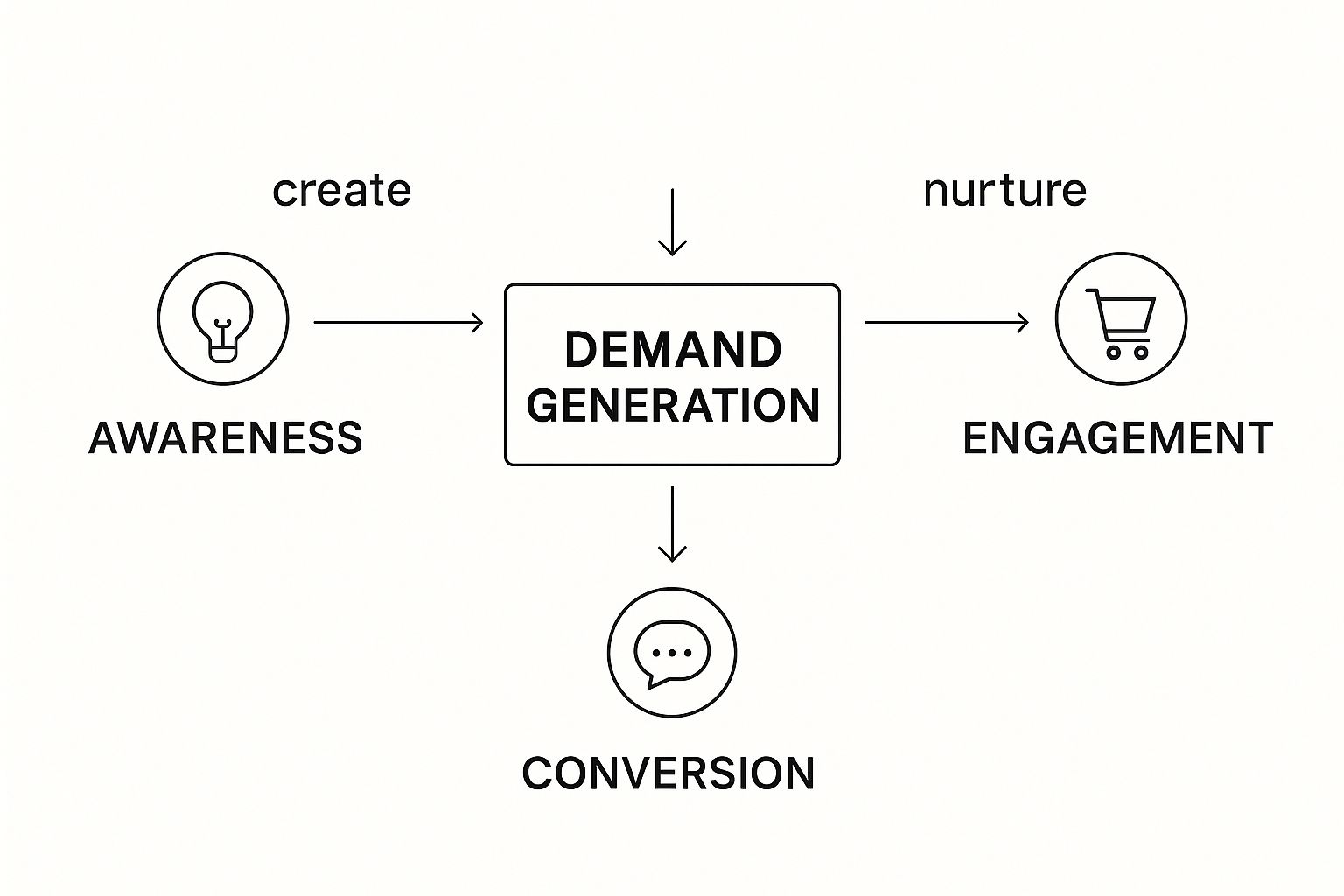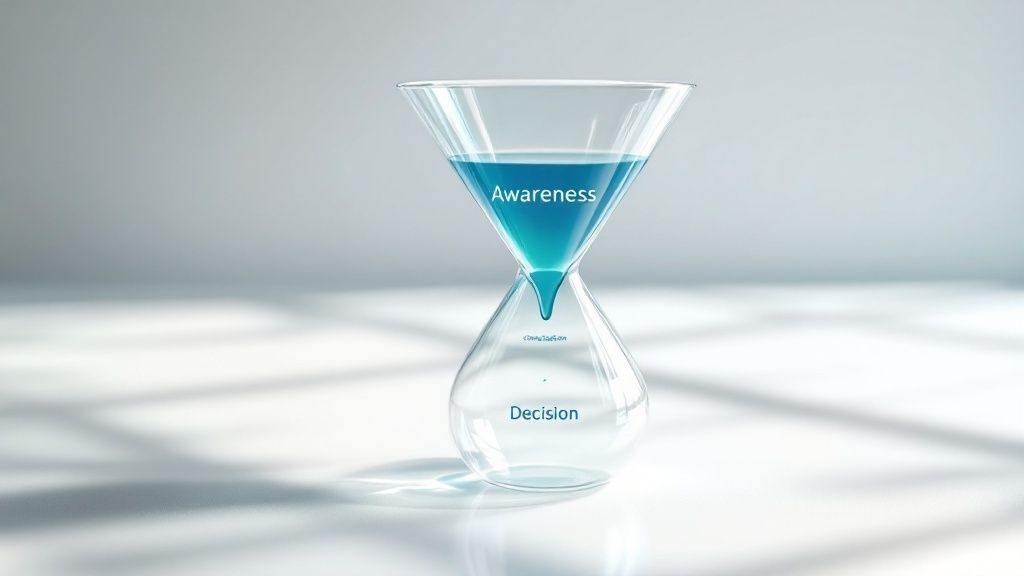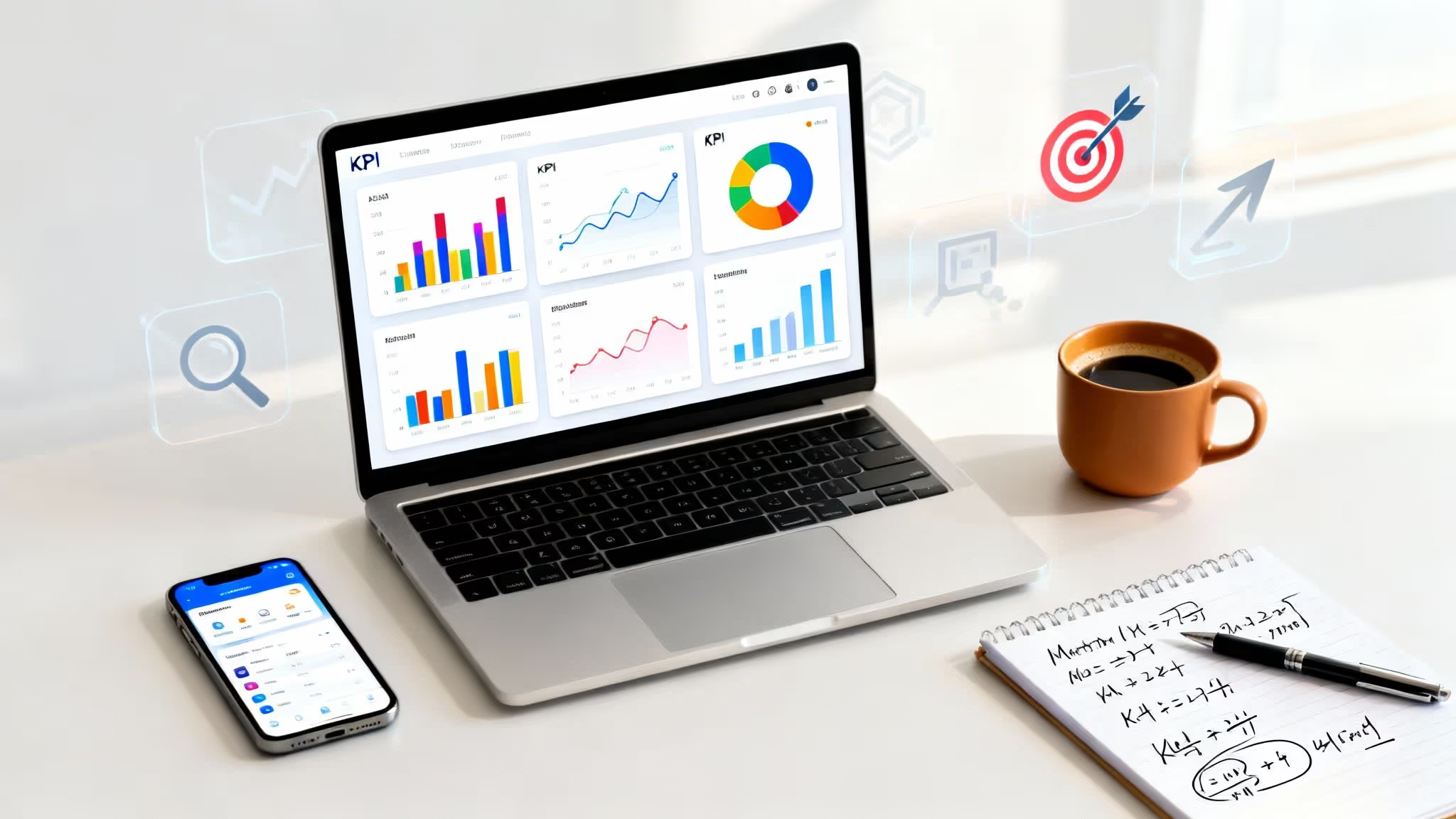At its core, demand generation marketing is the art and science of creating genuine, long-term interest in your company's solutions. It’s about making your ideal customers want to seek you out, rather than you chasing them with sales pitches. Think of it as a holistic strategy designed to build awareness and, more importantly, credibility.
Understanding Demand Generation Marketing
Demand generation is a comprehensive, data-driven approach that aligns sales and marketing teams to build a sustainable pipeline of high-quality prospects.
Imagine you're a farmer. You wouldn't just show up at the market hoping to sell whatever you find. Instead, you'd methodically prepare the soil, plant the right seeds, and nurture your crops. The goal isn't a one-time harvest; it's to ensure a healthy, predictable yield season after season. That's the essence of demand generation.
In contrast, traditional lead generation is like picking the fruit that’s already ripe. It's a critical step, but it’s a singular action focused on capturing existing interest. Demand generation is the strategic work that creates that interest in the first place, ensuring there’s always a steady supply of ripe fruit to harvest.
This long-term mindset is essential for B2B and professional services, where buying cycles are often lengthy and trust is paramount. Instead of pushing for an immediate sale, this strategy prioritizes educating your audience and establishing your brand as the go-to expert for solving their specific problems. It's about building a relationship long before asking for a commitment.
Of course, to do this right, you first have to know who you're talking to. Our guide on how to identify a target audience provides a solid framework for this essential first step.
Demand Generation vs. Lead Generation: A Clear Comparison
It’s easy to confuse these two terms, but they play distinct roles in your overall marketing strategy. To clarify, let's break down the fundamental differences between them.
As you can see, demand generation sets the stage. It's the foundational work that makes effective lead generation possible by creating an informed and engaged audience ready to take the next step.
The Core Stages of Demand
Demand generation isn't a single event; it's a full-funnel experience that guides potential customers on a journey of discovery and engagement. These stages work together to build momentum and turn initial curiosity into genuine interest.
- Awareness: This is the first handshake. It’s about introducing your brand to a broad but relevant audience—people who may not even realize they have a problem you can solve yet.
- Engagement: Once they know who you are, it's time to build trust. You nurture these prospects with valuable content like blogs, webinars, and in-depth reports that educate them and address their specific pain points.
- Conversion: At this final stage, the interest you've built is converted into a tangible action, like a demo request or a free trial signup. This is the moment a prospect officially becomes an active lead for your sales team.
This infographic gives a great visual of how these three core stages—Awareness, Engagement, and Conversion—flow together to create a powerful demand generation engine.

The key takeaway here is that a successful strategy is a connected process, not just a series of isolated tactics. It’s about turning passive observers into active, interested prospects who see you as the solution.
The Evolution of Demand Generation
Demand generation used to be a numbers game. The old playbook was all about volume—casting the widest net possible to pull in as many leads as you could, regardless of fit. This approach often left sales and marketing teams drowning in bloated pipelines full of unqualified prospects, wasting everyone's time.
But the landscape has shifted dramatically. The modern approach isn't about frantically stuffing the top of your funnel. It’s a complete mindset shift focused on building meaningful relationships that create predictable, sustainable revenue.

From Quantity to Quality
The biggest evolution in what is demand generation marketing is the pivot from chasing lead quantity to prioritizing lead quality. It boiled down to a simple, powerful realization: a handful of genuinely interested, well-informed prospects are infinitely more valuable than hundreds of disengaged contacts. It's about attracting the right people, not just any people.
This change wasn't just philosophical; it was powered by new tools and a deeper understanding of the customer journey. The rise of data analytics and marketing automation gave teams the power to track engagement, score leads based on actual behavior, and deliver personalized content at scale. Suddenly, you could see who was truly interested and why.
This shift fundamentally realigned marketing's purpose. The goal became not just to generate a lead, but to generate a conversation-ready prospect who already understands the value you provide.
Understanding the Modern Buyer
The buyer’s journey has also been completely transformed, making old tactics obsolete. Today's buyers are incredibly empowered. They conduct their own research, digging into peer reviews and content across multiple channels long before ever speaking to a salesperson. In fact, some studies suggest that over 80% of the B2B buying process is completed before a buyer reaches out directly.
This new reality makes the old "spray and pray" approach a guaranteed failure. Modern demand generation has adapted by becoming a sophisticated, data-driven discipline that synchronizes marketing and sales efforts across the entire buyer's journey. It emphasizes lead quality and uses methods like multi-touch attribution to determine which channels genuinely influence a final decision. You can find more insights on this in BlueWhale Research's piece about the future of full-funnel marketing.
By embracing this evolution, you can meet buyers where they are, deliver real value at every touchpoint, and build the trust that turns a flicker of interest into a lasting business partnership.
Core Pillars Of A Winning Demand Program
A potent demand engine rarely hinges on a single tactic. It's like a precision timepiece: gears, springs, and balance wheels must mesh flawlessly. If one cog slips, the entire mechanism grinds to a halt.
In marketing, this means weaving multiple strategies into a cohesive framework. Awareness sparks curiosity, curiosity builds trust, and trust fuels sustainable growth. When these pillars work in concert, you create a clear, predictable path from first touch to closed deal.
Strategic Content Marketing
Inform, don’t sell. At its core, Strategic Content Marketing answers real questions and solves genuine problems. When a prospect finds your blog post or webinar and thinks, “This helped me,” you’ve already won half the battle.
Examples of Strategic Content Marketing:
- Insightful blog posts and thought-leadership articles
- Live webinars, workshops, and roundtable discussions
- Original research reports packed with fresh data
- Engaging podcasts or short-form video series
But great content only works when it reaches your audience. Repurpose long-form assets into social snippets, infographics, or email series. Distribute it strategically—on LinkedIn for executives, in niche forums for practitioners—and watch your credibility grow.
Search Engine Optimization (SEO)
Great content is useless if no one can find it. SEO acts as a guide, leading the right prospects straight to your doorstep. It’s not magic—it’s methodical work on keywords, site health, and user experience.
SEO Best Practices:
- Conduct keyword research around buyer pain points
- Craft clear page titles, meta descriptions, and headers
- Optimize site speed, mobile responsiveness, and navigation
- Build quality backlinks and internal link structures
- Monitor rankings and user behavior with analytics tools
Think of SEO as the digital signposts directing buyers to your solutions. Without them, even your most valuable assets remain undiscovered.
A well-executed SEO strategy doesn’t just boost traffic; it connects your solutions to the people who need them most, turning passive searchers into an engaged audience.
Account-Based Marketing (ABM)
Sometimes you need a harpoon, not a net. Account-Based Marketing zeroes in on your highest-value targets, treating each as its own market. This precision ensures you speak directly to decision-makers who fit your ideal client profile.
Core ABM Tactics:
- Identify high-potential accounts using firmographics and intent data
- Create hyper-personalized campaigns (email sequences, microsites)
- Coordinate sales and marketing outreach for consistent messaging
- Leverage ABM platforms to track engagement and pipeline impact
ABM thrives when sales and marketing share a common playbook. Align on messaging, cadence, and success metrics so every touchpoint feels seamless. To implement this pillar effectively, you can learn more about crafting data-driven marketing solutions that pinpoint these opportunities.
Proven Demand Generation Tactics in Action
Theory provides the blueprint, but execution builds the house. Let's shift from strategic pillars to practical, real-world tactics that consistently spark genuine interest and build a high-quality pipeline.
These aren't just abstract ideas; they are proven methods for establishing your authority and engaging prospects on their own terms, long before they consider a purchase.

Establish Authority with In-Depth Industry Reports
One of the most powerful ways to generate demand is to become the source of truth in your industry. Instead of just commenting on trends, create them. Commissioning and publishing original research packed with fresh data and unique insights instantly elevates your brand to thought leader status.
This tactic works because it taps into a fundamental need: professionals are always hungry for data to validate their decisions and understand their market. By providing it, you offer immense value upfront, building credibility and brand affinity before a sales conversation ever begins.
Drive Engagement with Interactive Webinars
Webinars are much more than online presentations; they are live, interactive forums for education and engagement. A successful webinar focuses on solving a specific, pressing problem for your target audience, not on pitching your product. Think of it as a chance to showcase your expertise in a dynamic, helpful format.
When you include Q&A sessions, polls, and live discussions, you create a two-way dialogue that helps you understand your audience's pain points directly. This interaction is invaluable for nurturing high-intent prospects who are actively seeking solutions. This tactic is especially potent when promoted through targeted social media campaigns, which you can explore in our guide on how to advertise your business on social media.
When done right, a webinar isn't a sales pitch—it's a consultative experience. It provides tangible value that leaves attendees viewing your brand as a helpful, trusted advisor.
Build Trust with Compelling Case Studies
Nothing builds confidence like solid proof. Case studies are storytelling powerhouses that demonstrate your solution's real-world value. They move beyond a simple list of features to tell a clear story: problem, solution, and measurable results.
Recent trends confirm their power, with case studies being a preferred format for 57% of marketers because of how effectively they showcase business value. Interestingly, the same data reveals that only 29% of companies have a truly integrated brand and demand generation strategy, highlighting a significant opportunity for those who get it right. You can dig deeper into these demand generation benchmark survey findings for more context.
By providing clear evidence of success, you lower the perceived risk for potential buyers and make their decision to engage with you that much easier.
To bring this all together, here's a quick look at how these tactics fit into a broader strategy.
Effective Demand Generation Tactics and Their Goals
Each of these tactics plays a distinct yet complementary role. By mixing and matching them, you create a robust engine for generating sustained interest and demand.
Leveraging AI and Tech in Your Strategy
Technology isn't just a "nice-to-have" in demand generation; it's the engine that powers the whole operation. Artificial Intelligence (AI) and automation are transforming the landscape, giving businesses a level of speed and precision that was unimaginable just a few years ago.

This modern tech stack is about more than just automating tasks. It's about finding opportunities before your competitors do and delivering experiences that feel personal, even at scale.
Predictive Analytics and Hyper-Personalization
Imagine knowing your next best customer before they even fill out a form. That’s the power of predictive analytics. AI algorithms analyze vast amounts of data—from website behavior to industry trends—to flag accounts that are showing strong buying signals. This lets your team focus on the prospects most likely to convert, which is a massive efficiency booster.
At the same time, AI makes hyper-personalization a reality. Instead of broadcasting one-size-fits-all messaging, you can dynamically adjust content, ad copy, and even website layouts to match an individual's specific interests. It makes the entire buyer's journey feel more relevant and engaging.
The real power of AI in demand generation is its ability to translate mountains of data into clear, actionable intelligence. It allows for smarter, faster decisions that have a direct line to revenue.
This is why AI has become critical for demand gen success. For instance, companies that follow up on web leads within just five minutes are reportedly nine times more likely to convert them. That kind of speed is only possible with AI-powered automation.
Enhancing ABM and Attribution
Technology also puts strategies like Account-Based Marketing (ABM) on steroids. AI tools can:
- Identify Ideal Accounts: Pinpoint the exact companies that fit your ideal customer profile.
- Map Buying Committees: Identify key decision-makers within a target organization.
- Track Engagement: Monitor how and when key contacts interact with your brand across channels.
On top of that, sophisticated attribution models finally provide a clear picture of what's actually working. No more guessing which touchpoints pushed a deal over the line. Modern tech platforms can draw a straight line from marketing activities to pipeline and revenue, proving the real-world impact of your efforts. If you're looking to get started, our list of the 12 best AI tools for digital marketing is a great resource.
How to Measure Demand Generation Success
An effective demand generation strategy is only as good as its measurement. To understand your impact, you have to look past surface-level vanity metrics like page views. Instead, focus on business-critical KPIs that show a tangible return on investment.
Tracking the right numbers is how you prove the value of your marketing efforts and gain executive buy-in for future campaigns. It’s all about connecting your activities directly to revenue.
Core Metrics That Matter
To get a clear picture of success, start by tracking these essential indicators. They tell a story that goes beyond simple engagement, showing exactly how marketing influences the bottom line.
- Customer Acquisition Cost (CAC): This metric calculates the total cost to acquire a new customer, including all marketing and sales expenses. A declining CAC over time is a sure sign your demand engine is getting more efficient.
- Pipeline Velocity: This measures how quickly deals move through your sales pipeline, from the first touchpoint to a closed deal. Faster velocity suggests your efforts are attracting better-quality, higher-intent prospects.
- Marketing-Influenced Revenue: This is the total revenue from all deals where marketing had a touchpoint. It's a powerful metric for showing how your content and campaigns directly contribute to sales wins.
The ultimate goal of measurement is to shift the conversation from marketing being a cost center to a revenue driver. When you can show exactly how much pipeline your blog post or webinar generated, you’ve won.
Proving Program Effectiveness
A key part of measuring success is tracking how leads progress through the funnel. You need to monitor the conversion rate from Marketing Qualified Leads (MQLs) to Sales Qualified Leads (SQLs). A healthy MQL-to-SQL rate indicates that marketing isn't just generating interest—it's generating the right kind of interest that the sales team can act on.
This journey from initial awareness to a qualified sales opportunity is the heart of your demand generation program. By tracking these conversions and other essential digital marketing performance metrics, you can build a powerful, data-backed case for the value your strategy brings to the entire organization.
Got Questions About Demand Generation? We've Got Answers.
Even the best demand generation plans encounter questions. Let's tackle some of the most common ones that arise when turning strategy into reality.
What Is The Difference Between Demand Generation And Brand Awareness?
It's easy to confuse these two, but they play distinct roles. Think of it this way: brand awareness is about making sure people know your name. It’s about being recognizable in a crowded market.
Demand generation, on the other hand, is about making people want what you sell. It's not just about them knowing who you are; it's about educating them on a specific problem and positioning your product as the undeniable solution. Awareness is familiarity; demand generation is about creating genuine desire.
How Long Does It Take To See Results From A Demand Generation Strategy?
This is a marathon, not a sprint. If you're looking for an overnight sales explosion, demand gen isn't your play. You will likely see early indicators—like increased website traffic or content downloads—within the first few months.
But for results that truly move the needle, like a healthier sales pipeline and a clear lift in revenue, you should plan for a six to twelve-month runway. That timeline accounts for the trust you need to build and the time it takes to guide prospects from "just looking" to "ready to buy."
Patience is the secret ingredient. The payoff for a well-executed demand generation strategy is a sustainable, predictable pipeline of high-quality leads who arrive already convinced of your value.
Can A Small Business Implement Demand Generation With a Limited Budget?
Absolutely. You don't need a massive budget to get started. The key for small businesses is to be smart and focused.
Instead of trying to do everything at once, zero in on a few high-impact, low-cost tactics. Start a blog that addresses the specific pain points of your ideal customer. Focus on SEO to capture organic search traffic. Build a targeted email list and provide them with exclusive, valuable content. The key is to dominate a small niche with consistent value, not to boil the ocean.
Ready to build a predictable revenue engine with a strategy tailored to your business? Twelverays combines data-driven marketing with CRM expertise to turn interest into measurable growth. Learn how our award-winning agency can help you at https://twelverays.agency.





